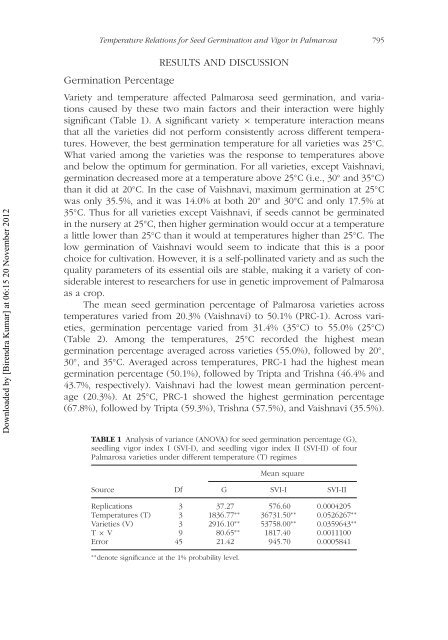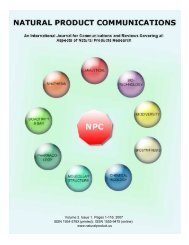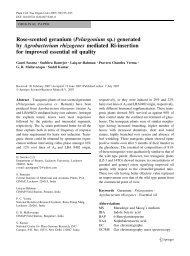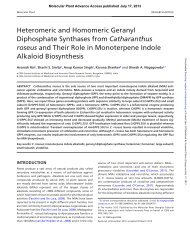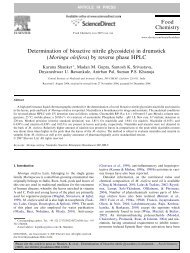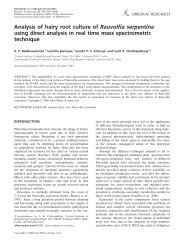Birendra Kumar*, SK Verma, G Ram,HP Singh. 2012 ... - CIMAP Staff
Birendra Kumar*, SK Verma, G Ram,HP Singh. 2012 ... - CIMAP Staff
Birendra Kumar*, SK Verma, G Ram,HP Singh. 2012 ... - CIMAP Staff
- No tags were found...
You also want an ePaper? Increase the reach of your titles
YUMPU automatically turns print PDFs into web optimized ePapers that Google loves.
Temperature Relations for Seed Germination and Vigor in Palmarosa 795<br />
Downloaded by [<strong>Birendra</strong> Kumar] at 06:15 20 November <strong>2012</strong><br />
RESULTS AND DISCUSSION<br />
Germination Percentage<br />
Variety and temperature affected Palmarosa seed germination, and variations<br />
caused by these two main factors and their interaction were highly<br />
significant (Table 1). A significant variety × temperature interaction means<br />
that all the varieties did not perform consistently across different temperatures.<br />
However, the best germination temperature for all varieties was 25 ◦ C.<br />
What varied among the varieties was the response to temperatures above<br />
and below the optimum for germination. For all varieties, except Vaishnavi,<br />
germination decreased more at a temperature above 25 ◦ C (i.e., 30 ◦ and 35 ◦ C)<br />
than it did at 20 ◦ C. In the case of Vaishnavi, maximum germination at 25 ◦ C<br />
was only 35.5%, and it was 14.0% at both 20 ◦ and 30 ◦ C and only 17.5% at<br />
35 ◦ C. Thus for all varieties except Vaishnavi, if seeds cannot be germinated<br />
in the nursery at 25 ◦ C, then higher germination would occur at a temperature<br />
a little lower than 25 ◦ C than it would at temperatures higher than 25 ◦ C. The<br />
low germination of Vaishnavi would seem to indicate that this is a poor<br />
choice for cultivation. However, it is a self-pollinated variety and as such the<br />
quality parameters of its essential oils are stable, making it a variety of considerable<br />
interest to researchers for use in genetic improvement of Palmarosa<br />
as a crop.<br />
The mean seed germination percentage of Palmarosa varieties across<br />
temperatures varied from 20.3% (Vaishnavi) to 50.1% (PRC-1). Across varieties,<br />
germination percentage varied from 31.4% (35 ◦ C) to 55.0% (25 ◦ C)<br />
(Table 2). Among the temperatures, 25 ◦ C recorded the highest mean<br />
germination percentage averaged across varieties (55.0%), followed by 20 ◦ ,<br />
30 ◦ , and 35 ◦ C. Averaged across temperatures, PRC-1 had the highest mean<br />
germination percentage (50.1%), followed by Tripta and Trishna (46.4% and<br />
43.7%, respectively). Vaishnavi had the lowest mean germination percentage<br />
(20.3%). At 25 ◦ C, PRC-1 showed the highest germination percentage<br />
(67.8%), followed by Tripta (59.3%), Trishna (57.5%), and Vaishnavi (35.5%).<br />
TABLE 1 Analysis of variance (ANOVA) for seed germination percentage (G),<br />
seedling vigor index I (SVI-I), and seedling vigor index II (SVI-II) of four<br />
Palmarosa varieties under different temperature (T) regimes<br />
Mean square<br />
Source Df G SVI-I SVI-II<br />
Replications 3 37.27 576.60 0.0004205<br />
Temperatures (T) 3 1836.77 ∗∗ 36731.50 ∗∗ 0.0526267 ∗∗<br />
Varieties (V) 3 2916.10 ∗∗ 53758.00 ∗∗ 0.0359643 ∗∗<br />
T × V 9 80.65 ∗∗ 1817.40 0.0011100<br />
Error 45 21.42 945.70 0.0005841<br />
∗∗<br />
denote significance at the 1% probability level.


